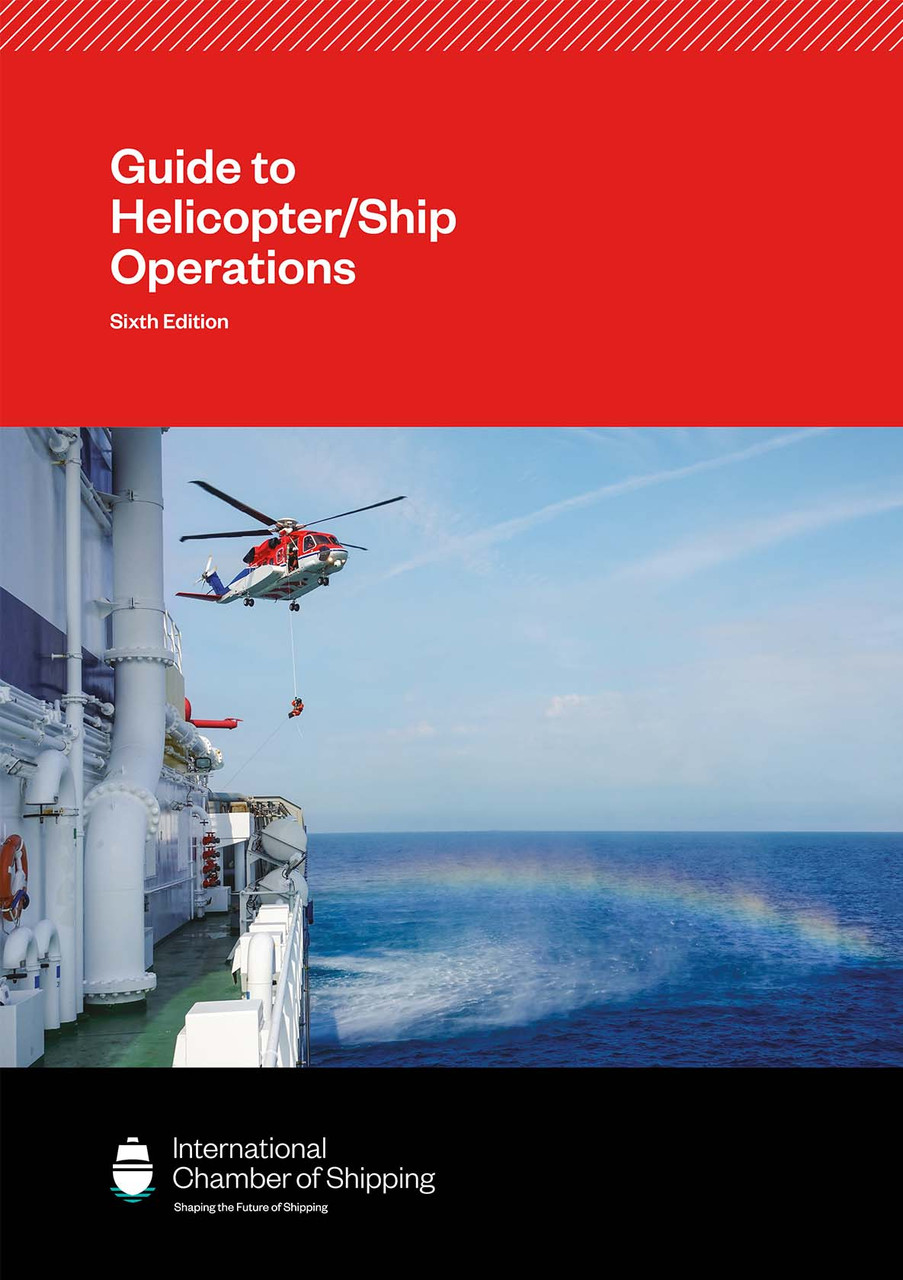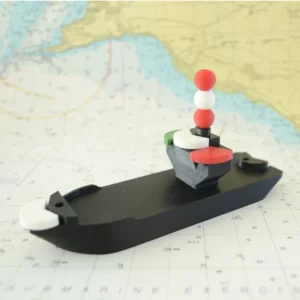Description
The newly updated edition of the ICS Guide to Helicopter/Ship Operations delivers practical, up-to-date guidance for shipping companies and crews, shaped by the latest input from maritime and aviation professionals.
Recognised as the industry standard for nearly 50 years, this guide continues to represent best practice and remains a carriage requirement under some flag states.
As the global fleet grows and technology evolves, the objective remains unchanged: to ensure helicopter/ship operations are carried out safely, efficiently, and in line with the highest professional standards.
Contents:
Chapter 1 General guidance
1.1 Introduction
1.2 Selection of a helicopter operator
1.3 Provision of helicopter landing/operating area information
Chapter 2 General ship requirements
2.1 Ship operating areas
2.1.1 Types of operating areas
2.1.2 Location and size of operating area – Landing
2.1.3 Location and size of operating area – Winching
2.1.4 Poop deck platforms
2.1.5 Structural considerations (purpose built and non-purpose built landing areas)
2.2 Details of landing area
2.2.1 General guidance on markings
2.2.2 Markings for a landing area located at the ship’s side
2.2.3 Markings for amidships centreline landing area with or without restricted access from the ship’s side
2.3 Environmental effects
2.3.1 General considerations
2.3.2 Aerodynamic effects
2.3.3 Wave motion effects
2.4 Details of winching area
2.4.1 Positioning a winching area
2.4.2 Winching area on the bridge wing
2.4.3 Marking a winching area
2.5 Additional considerations for helicopter operating areas
2.6 Night operations: landing and winching area lighting
2.7 Firefighting appliances and rescue equipment
Chapter 3 Principles of operating safety
3.1 General principles
3.2 Marine responsibilities
3.2.1 Risk assessments
3.2.2 Helicopter operations risk assessment
3.2.3 Ship operator
3.2.4 Master
3.2.5 Responsible officer
3.2.6 Deck crew
3.2.7 Administrator
3.2.8 Officer of the watch
3.2.9 Passengers
3.3 Aviation responsibilities
3.3.1 Helicopter operator
3.3.2 Helicopter pilot
3.3.3 Helicopter winch person/crew member
Chapter 4 Communications
4.1 Communications
4.1.1 General guidance
4.1.2 Communications equipment
4.2 Pre-arrival arrangements
4.2.1 Weather conditions
4.2.2 Departure of helicopter from the heliport
4.2.3 Pre-arrival checks
4.3 Navigation
4.3.1 Identification of the ship
4.3.2 Manoeuvrability
4.4 Signalling procedures
4.4.1 Ships’ international signals
4.4.2 Visual signals to helicopter
4.4.3 Loss of radio communications
4.4.4 Warning signal
Chapter 5 Operating procedures
5.1 Basic operating procedures
5.1.1 Officer of the watch
5.1.2 Deck crew
5.1.3 Pre-arrival checks on the ship
5.1.4 Firefighting
5.1.5 The operating area
5.1.6 The helicopter
5.1.7 Emergency shutdown
5.2 Instructions to helicopter passengers
5.2.1 Passenger pre-flight briefing
5.2.2 Instructions to helicopter passengers transferring to and from ships
5.2.3 List of items prohibited for carriage in passengers’ baggage or on their person
5.3 Marine pilot transfer
5.4 Freight handling procedures
5.4.1 General freight handling
5.4.2 Carriage of dangerous goods
5.4.3 Carriage of freight and/or baggage in the passenger cabin with passengers
5.5 Helicopter landing and unloading
5.5.1 Landing
5.5.2 Disembarking passengers and freight from the helicopter
5.5.3 Operational safety
5.6 Helicopter hovering
5.6.1 Winching operations
5.6.2 Underslung loads
5.7 Helicopter loading and departure
5.7.1 Loading passengers and freight
5.7.2 Take-off
5.7.3 Departing
Chapter 6 Bridge wing operations for marine pilot transfer
6.1 General
6.2 Background
6.3 Bridge wings
6.4 Risks and controls
6.4.1 Risks and general mitigating elements
6.4.2 Proximity of operations to command centre of ship
6.4.3 Varied size and form of bridge wing winching area
6.4.4 Elevation above sea level
6.4.5 Weather and sea conditions
6.4.6 Proximity to hot gases and other emissions from the funnel
6.4.7 Night operations
6.4.8 Ship/helicopter communication
6.4.9 Briefing of ship’s crew
6.4.10 Bridge wing winching clear zone markings
Chapter 7 Requirements specific to different ship types
7.1 Tankers
7.1.1 Oil tankers
7.1.2 Chemical/parcel tankers
7.1.3 Vapour dispersal
7.1.4 Vapour emission control
7.1.5 Safety
7.1.6 Freeboard
7.2 Bulk carriers and combination carriers
7.2.1 General
7.2.2 Geared bulk carriers
7.2.3 Gearless bulk carriers
7.3 Containerships
7.4 Gas carriers
7.4.1 Design limitations
7.4.2 Vapour emission control
7.5 General cargo ships
7.6 Passenger ships
7.7 Offshore operations
Chapter 8 Helicopter landing/operating area plan
8.1 Provision of helicopter landing/operating area plan
8.2 Helicopter landing/operating area plan
8.3 Completion of helicopter landing/operating area plan
8.4 Ship’s side helicopter landing/operating area plan
8.5 Centreline/amidships helicopter landing/operating area plan
8.6 ‘Winch only’ helicopter landing/operating area plan
Chapter 9 Emergency evacuation by air
9.1 General
9.2 Illness or injury evacuation
9.2.1 Requesting assistance
9.2.2 Preparation of patient
9.3 Emergency operating areas
Chapter 10 Emergencies
10.1 General
10.2 Helicopter accident procedure
10.3 Fire procedures
10.4 Emergency procedures
10.4.1 Crash on deck
10.4.2 Emergency/precautionary landing
10.4.3 Crash on deck, major fuel spillage – no fire
10.4.4 Helicopter incident on landing
10.4.5 Man overboard (MOB)
10.4.6 Helicopter ditching
10.5 Helicopter ditching
10.6 Plan of action
Appendices
Appendix A – Shipboard safety checklist for helicopter operations
Appendix B – Communications
Appendix C – Landing – Model risk assessment matrix
Appendix D – Winching – Model risk assessment matrix
Appendix E – Aide memoire for the responsible officer
Appendix F – Information to be given to passengers
Appendix G – Example Toolbox Talk before a helicopter operation
Appendix H – Commercial helicopters in marine use
Appendix I – Helicopter operating guidance
Appendix J – Relevant publications





